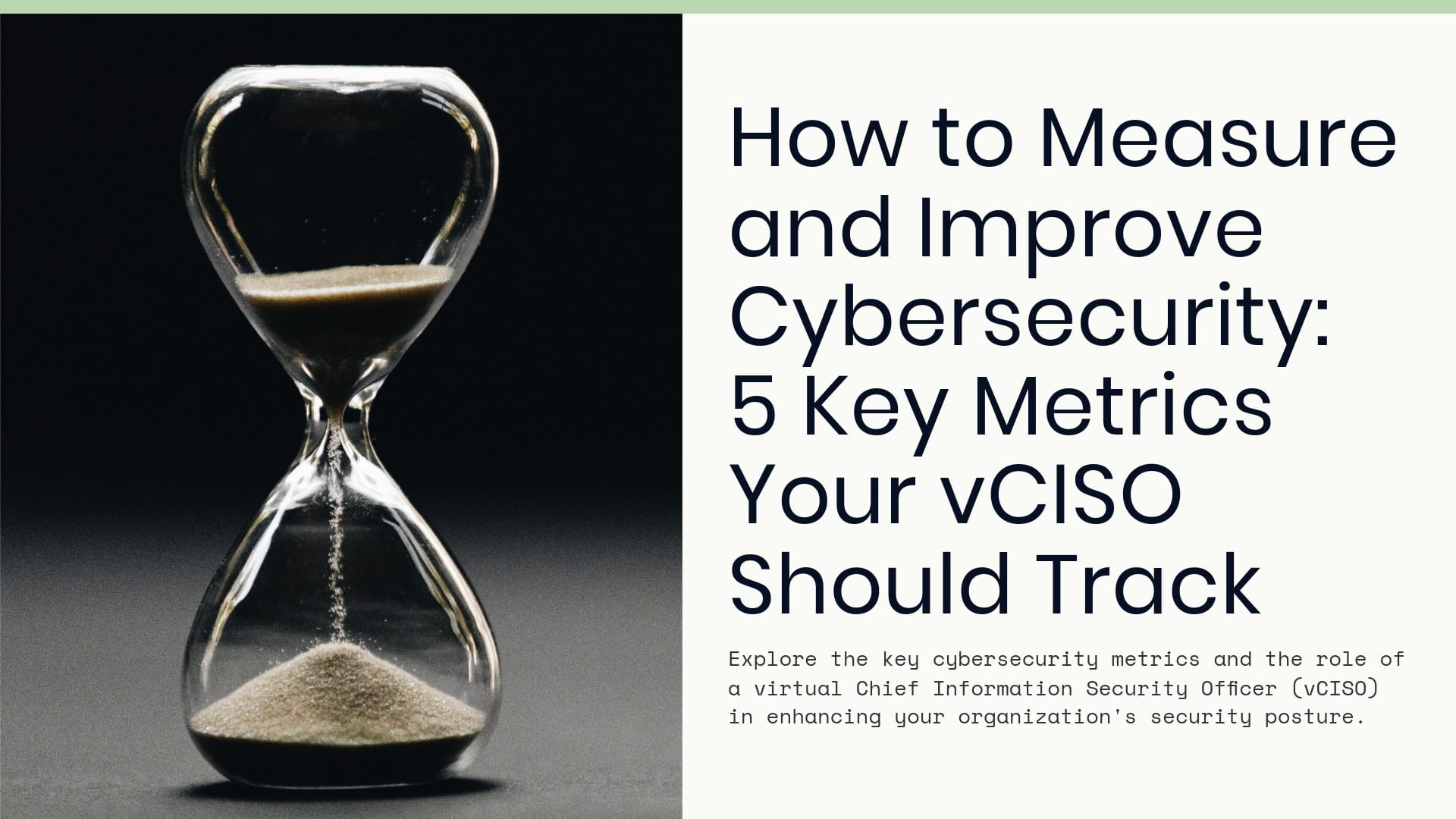Why Cybersecurity Metrics Matter
Cyber threats are evolving faster than ever, and businesses can no longer afford a reactive approach to security. A single undetected breach can lead to devastating financial and reputational damage. But how do you know if your cybersecurity efforts are actually working?
This is where cybersecurity metrics come into play. By tracking the right data, organizations can measure their security posture, identify weaknesses, and optimize their defenses before an attack occurs. However, many businesses struggle with knowing which metrics truly matter.
That’s where a Virtual Chief Information Security Officer (vCISO) becomes invaluable. A vCISO doesn’t just oversee cybersecurity strategy—they ensure your organization is tracking the most critical performance indicators and continuously improving your defenses.
In this article, we’ll explore the biggest cybersecurity challenges businesses face and the five key metrics your vCISO should be tracking to protect your organization. By the end, you’ll have a clear roadmap to enhance your cybersecurity performance and demonstrate real ROI.
- Why Cybersecurity Metrics Matter
- The Biggest Cybersecurity Challenges Businesses Face
- Five Key Cybersecurity Metrics That Matter
- Ready to Start Tracking Your Cybersecurity Metrics?
- How a vCISO Tracks and Enhances These Metrics
- The Value of Regular Security Reporting
- Optimizing Your Cybersecurity Performance
- Take Control of Your Cybersecurity Performance
The Biggest Cybersecurity Challenges Businesses Face
Cybersecurity isn’t just about deploying the latest tools—it’s about ensuring they work effectively against real threats. Many organizations invest in security solutions but still struggle with gaps in visibility, slow response times, and justifying their security budgets. Below are some of the biggest challenges businesses face when it comes to cybersecurity.
1. Evolving Cyber Threats
Cyberattacks are becoming more sophisticated, often bypassing traditional defenses. The longer a threat goes undetected, the more damage it can cause. According to IBM’s 2023 Cost of a Data Breach Report, the average time to identify and contain a breach is 277 days —nearly nine months of potential exposure. Businesses need a way to reduce this window significantly.
2. Compliance Pressures and Regulatory Requirements
Many industries must comply with stringent security regulations like GDPR, HIPAA, PCI DSS, and SOC 2. Failure to meet these standards can result in hefty fines and reputational damage. However, keeping up with compliance demands requires continuous monitoring, regular audits, and clear documentation—something that many businesses lack the resources to manage effectively.
3. Justifying Cybersecurity Investments to Leadership
Executives and board members want to see measurable ROI from cybersecurity spending. But proving the value of security investments is challenging when the main goal is preventing incidents rather than generating revenue. Without clear metrics, security teams struggle to justify budgets and secure necessary resources.
4. The Human Factor: Employee Awareness and Risk
Technology alone isn’t enough to prevent cyberattacks—human behavior plays a major role. Phishing remains one of the most common entry points for attackers, yet many employees lack proper cybersecurity training. A single mistake—like clicking a malicious link—can lead to a full-scale breach. Businesses need to measure and improve employee engagement with security best practices to minimize this risk.
Measuring Progress with the Right Cybersecurity Metrics
While these challenges can’t be fixed overnight, tracking the right cybersecurity metrics allows businesses to measure their progress in addressing them. By monitoring detection rates, response times, compliance status, security ROI, and user awareness, organizations can make informed decisions, fine-tune their security strategies, and demonstrate the effectiveness of their efforts.
In the next section, we’ll break down the five key cybersecurity metrics your vCISO should track to ensure continuous improvement and stronger defenses.
Five Key Cybersecurity Metrics That Matter
Addressing cybersecurity challenges requires more than just deploying security tools—it demands continuous measurement and improvement. But not all metrics are equally valuable. Tracking the wrong data can lead to wasted resources, while the right metrics provide actionable insights to strengthen defenses, improve response times, and ensure compliance.
1. Threat Detection Rate
(Threat Prevention & Detection)
What it measures: The percentage of detected threats compared to the total number of attempted attacks.
Why it matters: A high detection rate indicates that security tools and processes are effectively identifying threats before they cause harm. If this rate is low, attackers may be slipping through undetected.
How a vCISO improves it: By leveraging advanced threat intelligence platforms like CrowdStrike Complete and Falcon SOAR, a vCISO can enhance real-time threat detection and reduce the risk of unnoticed breaches.
2. Time to Respond (TTR)
(Incident Response & Containment)
What it measures: The time taken to contain and mitigate a detected security incident.
Why it matters: The longer a threat lingers, the more damage it can cause. Reducing response time minimizes financial, operational, and reputational risks. According to IBM, companies that contain breaches within 200 days save an average of $1.2 million compared to those that take longer.
How a vCISO improves it: A vCISO streamlines response times by implementing automated incident response workflows, well-defined playbooks, and real-time alerting through security orchestration tools like Falcon SOAR.
3. Compliance Status
(Compliance & Risk Management)
What it measures: The organization’s adherence to regulatory frameworks like GDPR, HIPAA, PCI DSS, and SOC 2.
Why it matters: Regulatory non-compliance can result in hefty fines, legal repercussions, and loss of customer trust. Tracking compliance ensures that security policies align with industry standards and reduces risk exposure.
How a vCISO improves it: A vCISO ensures compliance through regular audits, security control validation, and policy enforcement. They also help organizations stay ahead of evolving regulations by implementing proactive compliance roadmaps.
4. ROI of Security Initiatives
(Security ROI & Justification)
What it measures: The financial return on investment (ROI) of cybersecurity spending, comparing cost versus value.
Why it matters: Security investments often compete with other business priorities. Demonstrating ROI helps justify budgets and ensures leadership understands the impact of proactive cybersecurity measures.
How a vCISO improves it: A vCISO helps maximize security ROI by prioritizing high-impact initiatives, consolidating security tools, and reducing unnecessary expenses while ensuring risk mitigation and operational efficiency.
5. User Awareness & Engagement
(User Awareness & Insider Risk)
What it measures: Employee participation in cybersecurity training, phishing simulations, and adherence to security policies.
Why it matters: Human error remains a top cybersecurity risk. A well-trained workforce can significantly reduce incidents caused by phishing, weak passwords, and social engineering attacks.
How a vCISO improves it: A vCISO ensures that employees receive regular, relevant security training and that engagement metrics—such as phishing simulation click rates—are monitored and improved over time.
Turning Metrics into Actionable Insights
Tracking these cybersecurity metrics isn’t just about gathering data—it’s about using that data to drive continuous improvement. A vCISO plays a crucial role in analyzing trends, identifying weaknesses, and making strategic adjustments.
Ready to Start Tracking Your Cybersecurity Metrics?
Get our free Cybersecurity Metrics Tracker – a comprehensive tool designed specifically for SMBs to monitor all five key metrics we’ve discussed.
What’s Included:
- Executive summary dashboard template
- Annual tracking spreadsheet with sample data
- Step-by-step metric collection guide
- Industry benchmarks and targets
- Monthly security checklist
- Cyber insurance readiness tips
Perfect For:
- SMBs without dedicated security teams
- IT leaders who need to justify security spend
- Organizations preparing for audits
- Companies seeking cyber insurance
- Businesses wanting to improve security posture
Download Your Free Cybersecurity Metrics Tracker
No spam. Just practical cybersecurity tools for your business.
How a vCISO Tracks and Enhances These Metrics
Tracking cybersecurity metrics is one thing—turning them into actionable improvements is another. A vCISO ensures that your organization isn’t just collecting data but actively using it to strengthen security, reduce risk, and improve efficiency. Here’s how they do it.
1. Leveraging Advanced Monitoring and Analytics
A vCISO utilizes Next-Gen SIEM (Security Information and Event Management) and EDR (Endpoint Detection and Response) platforms to continuously track security performance. Solutions like CrowdStrike Complete and Falcon SOAR provide real-time data on threat detection, response times, and compliance status.
How it improves security:
- Aggregates security events from across the entire IT environment.
- Identifies suspicious patterns using AI-driven threat intelligence.
- Reduces false positives to prevent alert fatigue for security teams.
2. Implementing Proactive Threat Response Strategies
Metrics like Time to Respond (TTR) directly impact the effectiveness of security operations. A vCISO ensures that response times are minimized by:
- Automating threat containment using SOAR (Security Orchestration, Automation, and Response) tools.
- Establishing clear incident response playbooks for rapid escalation and remediation.
- Conducting tabletop exercises and attack simulations to improve team readiness.
How it improves security:
- Ensures threats are addressed before they escalate into major breaches.
- Reduces the window of exposure to minimize financial and reputational impact.
- Streamlines workflows between security, IT, and compliance teams.
3. Strengthening Compliance and Risk Management
Compliance isn’t just about meeting regulatory requirements —it’s about ensuring continuous security improvements that align with best practices. A vCISO tracks compliance status and proactively enhances security posture by:
- Conducting regular security audits and risk assessments.
- Mapping security controls to industry regulations like GDPR, HIPAA, and PCI DSS.
- Ensuring policy enforcement and employee adherence to compliance standards.
How it improves security:
- Reduces legal risks and regulatory fines.
- Increases customer and stakeholder trust.
- Creates a structured framework for ongoing security enhancements.
4. Measuring and Maximizing Security ROI
Security budgets are often scrutinized by leadership teams. A vCISO helps prove the financial value of security initiatives by:
- Tracking cost savings from prevented breaches.
- Comparing security investments to risk reduction metrics.
- Optimizing security tool usage to eliminate redundant spending.
How it improves security:
- Demonstrates the real-world impact of cybersecurity spending.
- Justifies budget allocations with data-driven insights.
- Aligns security investments with business objectives.
5. Enhancing User Awareness and Reducing Insider Risk
Human error is responsible for a majority of security incidents. A vCISO actively tracks and improves user engagement with security training by:
- Running phishing simulations and analyzing employee click rates.
- Delivering interactive cybersecurity training tailored to different roles.
- Monitoring security policy adherence and reinforcing best practices.
How it improves security:
- Reduces the likelihood of successful phishing and social engineering attacks.
- Encourages a culture of security awareness across the organization.
- Empowers employees to recognize and report threats proactively.
From Metrics to Continuous Improvement
A vCISO ensures that cybersecurity isn’t static—it’s evolving. By continuously tracking these key metrics and making data-driven adjustments, businesses can stay ahead of emerging threats and maintain a strong security posture.
The Value of Regular Security Reporting
Tracking cybersecurity metrics is only valuable if the insights are effectively communicated to decision-makers. Without clear, actionable reporting, security teams may struggle to secure budgets, optimize defenses, or demonstrate progress. A vCISO ensures that key stakeholders stay informed through structured reporting that highlights security performance, risks, and improvement areas.
1. Providing Transparency for Executives and Stakeholders
Security leaders and executives need to see the big picture —not just raw data. A vCISO translates technical cybersecurity metrics into business-relevant insights that help leadership teams make informed decisions.
Key Reports:
- Executive Security Dashboards: A high-level view of risk, compliance, and security performance.
- Quarterly Threat Landscape Reports: Insights on emerging threats and how the organization is defending against them.
- Security ROI Assessments: Demonstrates the financial impact of cybersecurity investments.
Why it matters:
- Aligns cybersecurity with business objectives.
- Helps executives prioritize security investments based on risk and ROI.
- Builds trust between security teams and leadership.
2. Turning Data into Actionable Security Insights
Raw security data can be overwhelming. A vCISO transforms complex security metrics into clear, actionable recommendations.
How a vCISO optimizes security insights:
- Identifies trends over time (e.g., improvement in threat detection rate).
- Pinpoints vulnerabilities that need immediate action (e.g., a rise in phishing click rates).
- Recommends security strategy adjustments based on risk assessment data.
Why it matters:
- Ensures security decisions are backed by real-world data rather than guesswork.
- Helps IT and security teams focus on high-impact security improvements.
- Prevents blind spots in cybersecurity posture by identifying emerging threats.
3. Supporting Compliance and Regulatory Requirements
Many industries require detailed security documentation to meet compliance obligations. A vCISO ensures that security reports are structured to align with regulatory audits and legal requirements.
Key Compliance Reports:
- Audit Readiness Reports: Ensures the company is prepared for GDPR, HIPAA, PCI DSS, and other audits.
- Incident Response Reports: Documents how security incidents were detected, contained, and resolved.
- Policy Adherence Reports: Measures employee compliance with security policies and training programs.
Why it matters:
- Reduces the risk of regulatory penalties.
- Strengthens compliance posture with ongoing monitoring and reporting.
- Simplifies the audit process with ready-to-go security documentation.
4. Enabling Real-Time Monitoring with Dynamic Dashboards
Static reports provide valuable snapshots, but real-time dashboards offer continuous visibility into security performance. A vCISO ensures that organizations use Next-Gen SIEM and security analytics tools to track cybersecurity metrics dynamically.
Features of real-time security dashboards:
- Live monitoring of security events (e.g., active threats, system vulnerabilities).
- Custom alerts for critical incidents (e.g., a major compliance violation).
- Automated reports with trend analysis to track improvement over time.
Why it matters:
- Allows for faster responses to security incidents.
- Helps security teams quickly adjust strategies based on evolving threats.
- Provides leadership with up-to-date security insights without waiting for quarterly reports.
Better Reporting, Stronger Cybersecurity
Regular security reporting isn’t just about compliance—it’s about continuous improvement. A vCISO ensures that cybersecurity metrics are tracked, analyzed, and communicated effectively, helping businesses stay secure, proactive, and prepared.
Optimizing Your Cybersecurity Performance
Tracking cybersecurity metrics and generating reports is only the first step. The real value comes from using that data to drive continuous improvement. A vCISO helps organizations go beyond monitoring by optimizing security strategies, improving efficiency, and ensuring long-term resilience.
1. Identifying and Closing Security Gaps
Cyber threats evolve rapidly, and yesterday’s defenses may not be enough today. A vCISO continuously analyzes security metrics to pinpoint vulnerabilities and prioritize improvements.
How a vCISO enhances security posture:
- Uses threat detection data to fine-tune security tools and reduce false negatives.
- Improves incident response efficiency by refining workflows and automating threat containment.
- Conducts regular risk assessments to stay ahead of emerging threats.
Impact:
- Reduces the likelihood of undetected breaches.
- Ensures faster containment of security incidents.
- Keeps security measures aligned with evolving threats.
2. Fine-Tuning Security Investments for Maximum ROI
Budget constraints often force organizations to make tough decisions about security spending. A vCISO ensures that every dollar spent on cybersecurity delivers measurable value.
Key ways a vCISO maximizes ROI:
- Eliminates redundant security tools that provide overlapping functionality.
- Prioritizes high-impact security initiatives that deliver the best risk reduction.
- Uses quantifiable data to justify security budgets to executives.
Impact:
- Helps leadership see cybersecurity as an investment, not an expense.
- Reduces wasteful spending while maintaining strong defenses.
- Aligns security investments with business growth objectives.
3. Strengthening Compliance and Regulatory Readiness
Regulations are constantly changing, and failing to comply can result in hefty fines and reputational damage. A vCISO ensures that security policies and controls evolve with compliance requirements.
Proactive compliance strategies:
- Tracks compliance metrics to ensure ongoing adherence to GDPR, HIPAA, PCI DSS, and SOC 2.
- Conducts regular security audits to identify compliance gaps before auditors do.
- Implements automated compliance monitoring tools to streamline reporting.
Impact:
- Reduces regulatory risks and legal exposure.
- Keeps the organization ahead of compliance changes.
- Enhances customer trust by demonstrating security maturity.
4. Cultivating a Security-First Culture
Technology alone can’t prevent every attack—employee behavior plays a critical role in cybersecurity. A vCISO ensures that security awareness and engagement become part of the company culture.
Strategies for improving security awareness:
- Conducts ongoing phishing simulations to measure employee resilience to social engineering.
- Implements role-based security training to educate employees on threats relevant to their job functions.
- Tracks security policy adherence and reinforces best practices with leadership buy-in.
Impact:
- Reduces human errors that lead to security incidents.
- Empowers employees to recognize and report threats.
- Creates a culture where security is a shared responsibility.
Take Control of Your Cybersecurity Performance
A strong security posture doesn’t happen by accident—it requires continuous monitoring, strategic improvements, and expert oversight. A vCISO ensures that your cybersecurity efforts are not just reactive but proactively optimized for long-term success.
Are your cybersecurity metrics where they should be? Let’s talk.
What to Expect:
- Review your current cybersecurity approach
- Identify potential blind spots and vulnerabilities
- Receive practical next steps tailored to your business
- Get expert guidance with no sales pressure
- Improve your security posture with confidence



